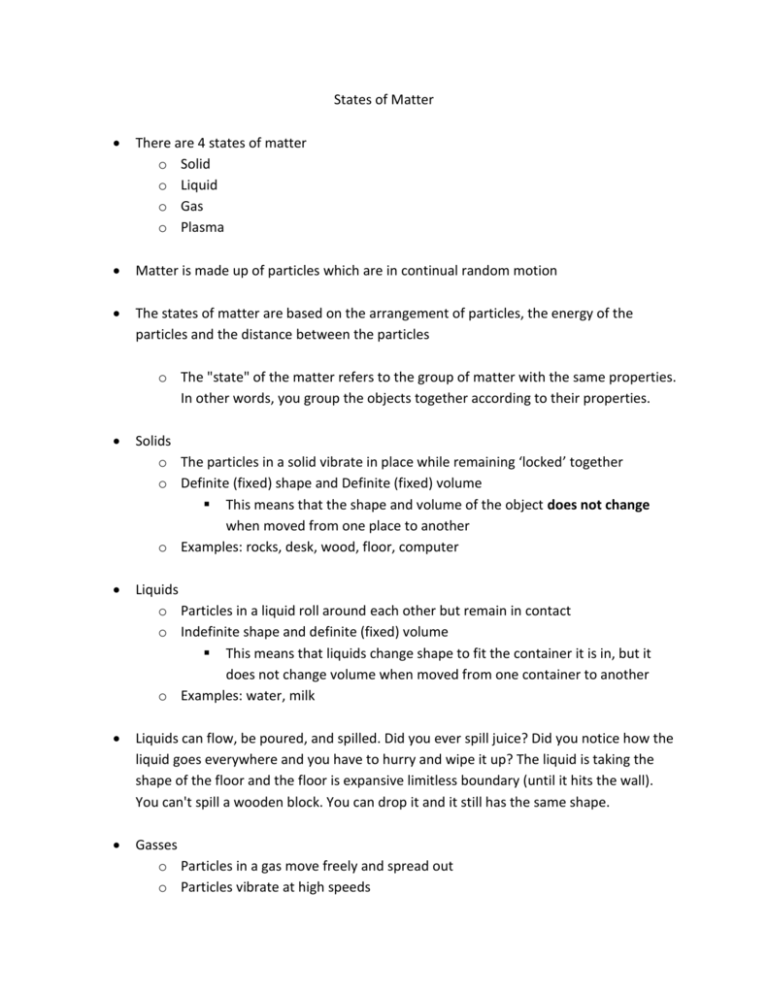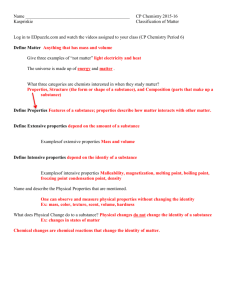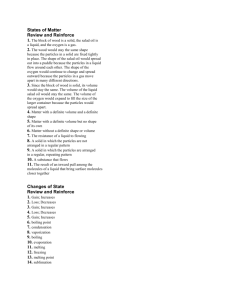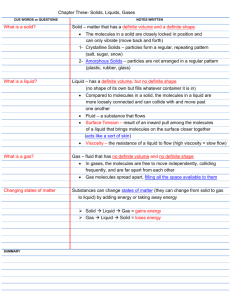States of Matter notes tt - DiMaggio
advertisement

States of Matter There are 4 states of matter o Solid o Liquid o Gas o Plasma Matter is made up of particles which are in continual random motion The states of matter are based on the arrangement of particles, the energy of the particles and the distance between the particles o The "state" of the matter refers to the group of matter with the same properties. In other words, you group the objects together according to their properties. Solids o The particles in a solid vibrate in place while remaining ‘locked’ together o Definite (fixed) shape and Definite (fixed) volume This means that the shape and volume of the object does not change when moved from one place to another o Examples: rocks, desk, wood, floor, computer Liquids o Particles in a liquid roll around each other but remain in contact o Indefinite shape and definite (fixed) volume This means that liquids change shape to fit the container it is in, but it does not change volume when moved from one container to another o Examples: water, milk Liquids can flow, be poured, and spilled. Did you ever spill juice? Did you notice how the liquid goes everywhere and you have to hurry and wipe it up? The liquid is taking the shape of the floor and the floor is expansive limitless boundary (until it hits the wall). You can't spill a wooden block. You can drop it and it still has the same shape. Gasses o Particles in a gas move freely and spread out o Particles vibrate at high speeds o The amount of empty space between gas particles can change o Indefinite volume and Indefinite shape This means it changes shape and volume to fill whatever container it’s in, whether it’s a balloon, a jar, or the classroom Plasma o Ionized (electrically charged particles) gas o Happens when temperatures rise above 1000 degrees Celsius o Good conductor of electricity o Affected by magnetic fields o Indefinite volume o Indefinite shape o Common state of matter o Examples: flames, lightening, Aurora Borealis (Northern Lights) State/phase of Matter Arrangement of Particles Solid Tightly packed together or locked together Loosely packed together but still in contact Liquid Gas Plasma Freely moving Freely moving Energy Distance of Volume of Particles Particles Vibrate Close Definite in place together (fixed) Roll over one another Fast moving Fast moving Shape Examples Definite (fixed) Desk, rocks, tress Close together but far enough apart to move far apart Definite (fixed) Indefinite Water, milk Indefinite Indefinite Far apart Indefinite Indefinite Air, helium, steam Fire, lightening, Northern Lights, sun Phase/state Changes A change of state is the change of a substance from one physical form to another. The particles have different amounts of energy when the substance is in different states. Melting o Involves a solid changing into a liquid o The temperature at which a solid changes to a liquid is its melting point. o Ice does this at room temperature and candle wax does this when the candle burns o Heat goes into the solid form to make it melt (adding heat/energy) o Starting phase: solid o Ending phase: liquid Freezing o Involves a liquid changing into a solid o This happens when the temperature is below the freezing point (The temperature at which a liquid changes to a solid is its freezing point) of the liquid o Heat leaves the liquid to make it freeze (remove heat/energy) o Starting phase: liquid o Ending phase: solid Vaporization o Includes boiling and evaporation o Boiling: is the change of a liquid to a gas throughout the liquid. The temperature at which a liquid boils is its boiling point. o Evaporation: the change of state from a liquid to a gas. Evaporation can occur at the surface of a liquid that is below its boiling point. o Heat enters the liquid as it speeds up the particles causing them to be free (add heat/energy) o Starting phase: liquid o Ending phase: gas Condensation o The change of state from a gas to a liquid. o Happens when heat is traveling out of the gas (removing heat/energy) o Removing heat energy slows the movement of gas particles which allows them to clump together. o Starting phase: gas o Ending phase: liquid Sublimation o the change of state in which a solid changes directly into a gas skipping the liquid state o Dry ice is an example- goes from frozen carbon dioxide directly to CO2 gas o Heat goes into the solid causing the particles to speed up and break away rapidly (heat/energy added) o Staring phase: solid o Ending phase: gas Solid to liquid Phase Changes What the phase change is called Melting Liquid to solid Freezing Liquid to gas Gas to liquid Vaporization (boiling and evaporation) Condensation Solid to gas Sublimation Description of phase change Movement of heat during phase change Heat goes into the solid to make it melt Heat comes out of the liquid to make it freeze Heat goes into the liquid as it vaporizes Heat leaves the gas as it condenses Heat goes into the solid as it sublimates









